Quality Evaluation of Ready-to-Use Various Brown Rice (Oryza sativa) Powder Using Extrusion Process
Abstract
1. Introduction
2. Materials and Methods
2.1. Raw Materials
2.2. Proximate Analysis of Brown Rice Grain
2.3. Rice Powder Preparation
2.4. Physicochemical Analysis of Rice Powder
2.4.1. Color
2.4.2. Moisture and Water Activity (aw)
2.4.3. Aroma Analysis of Rice Powder
2.4.4. Water Absorption Index (WAI), Water Solubility Index (WSI), and Swelling Power (SP)
2.4.5. Viscosity Analysis
2.5. Bioactive Properties of Rice Powder
2.5.1. Preparation of Crude Instant Rice Powder Extracts
2.5.2. Determination of Total Monomeric Anthocyanin Content
2.5.3. Determination of Total Phenolic Compounds
2.5.4. DPPH (1,1-Diphenyl-2-picrylhydrazyl) Radical Scavenging Assay
2.5.5. Ferric Reducing Antioxidant Power (FRAP) Assay
2.5.6. In Vitro CaOx Crystal Formation Assay
2.6. Statistical Analysis
3. Results and Discussion
3.1. Appearance and Proximate Analysis of Brown Rice Grains

3.2. Physicochemical Analysis of Brown Rice Grain Powder
3.2.1. Appearances and Color
3.2.2. Moisture and aw
3.2.3. Aroma Analysis
3.2.4. WAI, WSI, and SP
3.2.5. Viscosity
3.3. Bioactive Properties of Brown Rice Grain Powder
3.3.1. Antioxidant Activities
3.3.2. Anti-CaOx Crystal Formation
3.4. PCA and Heatmap Analysis
4. Conclusions
Author Contributions
Funding
Institutional Review Board Statement
Informed Consent Statement
Data Availability Statement
Acknowledgments
Conflicts of Interest
Abbreviations
| ANOVA | Analysis of variance |
| aw | Water activity |
| CaCl2 | Calcium chloride |
| CaOx | Calcium oxalate |
| D | Barrel bore |
| DNA | Deoxyribonucleic acid |
| DPPH | 1,1-diphenyl-2-picrylhydrazyl radical scavenging assay |
| FRAP | Ferric reducing antioxidant power assay |
| GAE | Gallic acid equivalent |
| HTST | High temperature short time |
| IC50 | Inhibitory concentration |
| KC | Positive control |
| L | Barrel length |
| Na2C2O4 | Sodium oxalate |
| NaCl | Sodium chloride |
| PCA | Principal component analysis |
| R1 | RD43 |
| R2 | Hom Mali 105 |
| R3 | RD6 |
| R4 | Khiaw Ngoo |
| R5 | Hom Mali Daeng |
| R6 | Riceberry |
| R7 | Leum Pua |
| R8 | Kum Lanna |
| RS | Resistant starch |
| RVA | Rapid visco analyzer |
| RVU | Rapid viscosity unit |
| SP | Swelling power |
| WAI | Water absorption index |
| Wg | The weight of the gel |
| Ws | The initial weight of the sample |
| WSI | Water solubility index |
| Wsl | The weight of solids obtained from the supernatant |
References
- Tefera, S.; Aragaw, M.; Molla, T. Agro-morphological and physiochemical studies of upland rice (Oryza sativa L.) varieties for variability with yield and quality related parameters in south Gondar district, Ethiopia. Heliyon 2023, 9, e15186. [Google Scholar] [CrossRef]
- Saito, K.; Senthilkumar, K.; Dossou-Yovo, E.R.; Ali, I.; Johnson, J.-M.; Mujawamariya, G.; Rodenburg, J. Status quo and challenges of rice production in sub-Saharan Africa. Plant Prod. Sci. 2023, 26, 320–333. [Google Scholar] [CrossRef]
- Fatchiyah, F.; Safitri, A.; Palis, C.N.; Sari, D.R.T.; Suyanto, E.; Fajriani, S.; Kurnianingsih, N.; Nugraha, Y.; Sitaresmi, T.; Kusbiantoro, B.; et al. Bioactive compound profile and their biological activities of endogenous black rice from Java and East Nusa Tenggara. CYTA J. Food. 2023, 21, 159–170. [Google Scholar] [CrossRef]
- Roy, P.; Ijiri, T.; Nei, D.; Takahiro, O.; Okadome, H.; Nakamura, N.; Shiina, T. Cooking properties of different forms of rice cooked with an automatic induction heating system rice cooker. Asian J. Food Agro-Ind. 2010, 3, 373–388. [Google Scholar]
- Pensri, J.; Supot, D.; Wananya, T. The outstanding features of innovative riceberry product influence on purchasing intention of elderly consumers in Thailand. GMSARN Int. J. 2021, 15, 21–26. [Google Scholar]
- Ronie, M.E.; Hasmadi, M. Factors affecting the properties of rice flour: A review. Food Res. 2022, 6, 1–12. [Google Scholar] [CrossRef] [PubMed]
- Wiriyawattana, P.; Suwonsichon, S.; Suwonsichon, T. Effects of drum drying on physical and antioxidant properties of Riceberry flour. Agric. Nat. Resour. 2018, 52, 445–450. [Google Scholar] [CrossRef]
- Müller, A.; Nunes, M.T.; Maldaner, V.; Coradi, P.C.; de Moraes, R.S.; Martens, S.; Leal, A.F.; Pereira, V.F.; Marin, C.K. Rice drying, storage and processing: Effects of post-harvest operations on grain quality. Rice Sci. 2022, 29, 16–30. [Google Scholar] [CrossRef]
- Kanha, N.; Regenstein, J.M.; Laokuldilok, T. Optimization of process parameters for foam mat drying of black rice bran anthocyanin and comparison with spray- and freeze-dried powders. Dry. Technol. 2020, 40, 581–594. [Google Scholar] [CrossRef]
- Oyinloye, T.M.; Yoon, W.B. Effect of freeze-drying on quality and grinding process of food produce: A review. Processes 2020, 8, 354. [Google Scholar] [CrossRef]
- Liu, X.; Zhao, X.; Ma, C.; Wu, M.; Fan, Q.; Fu, Y.; Zhang, G.; Bian, X.; Zhang, N. Effects of extrusion technology on physicochemical properties and microstructure of rice starch added with soy protein isolate and whey protein isolate. Foods 2024, 13, 764. [Google Scholar] [CrossRef]
- Wongsa, J.; Rungsardthong, V.; Uttapap, D.; Lamsal, B.P.; Puttanlek, C. Effect of extrusion conditions, monoglyceride and gum arabic addition on physical and cooking properties of extruded instant rice. Appl. Sci. Eng. Prog. 2017, 10, 1–10. [Google Scholar] [CrossRef]
- Farahanah, I.; Sahudin, S.; Mohsin, H.F.; Ariffin, S.A.; Aminuddin, L.D. Understanding investigational perspective of antioxidant and antibacterial properties of rice. Rice Sci. 2025, 32, 15–31. [Google Scholar] [CrossRef]
- Liang, C.; Guan, Z.; Wei, K.; Yu, W.; Wang, L.; Chen, X. Characteristics of antioxidant capacity and metabolomics analysis of flavonoids in the bran layer of green glutinous rice (Oryza sativa L. var. Glutinosa Matsum). Sci. Rep. 2023, 13, 16372. [Google Scholar] [CrossRef] [PubMed]
- Zhu, J.; Wang, R.; Zhang, Y.; Lu, Y.; Cai, S.; Xiong, Q. Metabolomics reveals antioxidant metabolites in colored rice grains. Metabolites 2024, 14, 120. [Google Scholar] [CrossRef] [PubMed]
- Joardar, S.; Duarah, P.; Yanase, E.; Purkait, M.K. Optimization of inositol extraction from Japanese rice bran and its potential application in inhibiting calcium oxalate crystallization for urolithiasis prevention. ACS Food Sci. Technol. 2024, 4, 3149–3160. [Google Scholar] [CrossRef]
- Official Methods of Analysis, 22nd ed.; AOAC International: Rockville, MD, USA, 2023; Available online: https://academic.oup.com/aoac-publications/book/45491/chapter/392327022 (accessed on 5 November 2025).
- Harasym, J.; Satta, E.; Kaim, U. Ultrasound treatment of buckwheat grains impacts important functional pProperties of resulting flour. Molecules 2020, 25, 3012. [Google Scholar] [CrossRef]
- Wongsaipun, S.; Krongchai, C.; Jakmunee, J.; Kittiwachana, S. Rice grain freshness measurement using rapid visco analyzer and chemometrics. Food Anal. Methods 2018, 11, 613–623. [Google Scholar] [CrossRef]
- Khawsuk, W.; Semangoen, T.; Nuurai, P. Effects of the local purple sticky rice bran extract on antioxidant activity and calcium oxalate crystal formation and aggregation in vitro. J. Health Sci. Altern. Med. 2022, 4, 1–7. [Google Scholar]
- Ly, H.T.; Nguyen, M.T.; Pham, T.H.; Nguyen, H.D.; Nguyen, M.K. Anti-urolithic, anti-inflammatory and antibacterial properties of various extracts from Musa balbisiana Colla fruits. Pharm. Sci. Asia 2021, 48, 388–401. [Google Scholar]
- Huang, G.; Guo, L.; Zeng, Y.; Huang, S.; Zeng, Y.; Xie, X. Changes in the grain yield and quality of early indica rice from 2000 to 2020 in Southern China. Agronomy 2024, 14, 295. [Google Scholar] [CrossRef]
- Prathepha, P. New data on the domestication of the two subspecies indica and japonica of the Asian cultivated rice (Oryza sativa) during the Dvaravati period in Thailand and Lao PDR. Songklanakarin J. Sci. Technol. 2016, 38, 495–500. [Google Scholar]
- Palacios-Cabrera, H.; Jimenes-Vargas, K.; González, M.; Flor-Unda, O.; Almeida, B. Determination of moisture in rice Grains based on visible spectrum analysis. Agronomy. 2022, 12, 3021. [Google Scholar] [CrossRef]
- Sanpawithayakul, K.; Kaewprasert, N.; Tantiyavarong, P.; Wichansawakun, S.; Somprasit, C.; Srichan, C.; Tanathornkeerati, N.; Tharavanij, T. Effects of the consumption of low to medium glycemic index–based rice on the rate of insulin initiation in patients with gestational diabetes: A triple-blind, randomized, controlled trial. Clin Ther. 2023, 45, 347–353. [Google Scholar] [CrossRef] [PubMed]
- Suklaew, P.O.; Chusak, C.; Adisakwattana, S. Physicochemical and functional characteristics of RD43 rice flour and its food application. Foods 2020, 9, 1912. [Google Scholar] [CrossRef] [PubMed]
- Boontakham, P.; Sookwong, P.; Jongkaewwattana, S.; Wangtueai, S.; Mahatheeranont, S. Comparison of grain yield and 2-acetyl-1-pyrroline (2AP) content in leaves and grain of two Thai fragrant rice cultivars cultivated at greenhouse and open-air conditions. Aust. J. Crop Sci. 2019, 13, 159–169. [Google Scholar] [CrossRef]
- Srinang, P.; Khotasena, S.; Sanitchon, J.; Chankaew, S.; Jogloy, S.; Monkham, T. New source of rice with a low amylose content and slow in vitro digestion for improved health benefits. Agronomy 2023, 13, 2622. [Google Scholar] [CrossRef]
- Department of Intellectual Property. Thai Geographical Indication. Available online: https://www.ipthailand.go.th/th/gi-011/item/sorchor62100126.html (accessed on 9 September 2025).
- Chantaraponpan, A.; Sakunwiwat, W.; Meekeaw, M. Physical and chemical properties of Hom Mali Deang brown rice at 3-stages of grain development. Khon Kaen Agric. J. 2019, 47, 671–678. [Google Scholar]
- Raungrusmee, S.; Koirala, S.; Anal, A.K. Effect of physicochemical modification on granule morphology, pasting behavior, and functional properties of riceberry rice (Oryza sativa L.) starch. Food Chem. Adv. 2022, 1, 100116. [Google Scholar] [CrossRef]
- Lomthong, T.; Saithong, P. Feasibility of Leum Pua glutinous rice substrate for sugar syrup and vinegar production by raw starch degrading enzyme hydrolysis. Int. Food Res. J. 2019, 26, 1515–1523. [Google Scholar]
- Lerdluksamee, C.; Srikaeo, W.; Srikaeo, K. Glycemic responses of special rice: Case study in Thai geographical indication rice cultivars. Agric. Nat. Resour. 2024, 58, 13–22. [Google Scholar] [CrossRef]
- Yamuangmorn, S.; Prom-u-Thai, C. The potential of high-anthocyanin purple rice as a functional ingredient in human health. Antioxidants 2021, 10, 833. [Google Scholar] [CrossRef] [PubMed]
- Ali, M.M.; Hashim, N. Exploring nutritional compositions, volatile compounds, health benefits, emerging processing technologies, and potential food products of glutinous rice: A review. Rice Sci. 2024, 31, 251–268. [Google Scholar] [CrossRef]
- Senthil, T.S.; Muthukumarasamy, N.; Velauthapillai, D.; Agilan, S.; Thambidurai, M.; Balasundaraprabhu, R. Natural dye (cyanidin 3-O-glucoside) sensitized nanocrystalline TiO2 solar cell fabricated using liquid electrolyte/quasi-solid-state polymer electrolyte. Renew. Energy 2011, 36, 2484–2488. [Google Scholar] [CrossRef]
- Chen, T.; Xie, L.; Wang, G.; Jiao, J.; Zhao, J.; Yu, Q.; Chen, Y.; Shen, M.; Wen, H.; Ou, X.; et al. Anthocyanins-natural pigment of colored rice bran: Composition and biological activities. Food Res. Int. 2024, 175, 113722. [Google Scholar] [CrossRef]
- Jung, H.; Lee, Y.J.; Yoon, W.B. Effect of moisture content on the grinding process and powder properties in food: A review. Processes 2018, 6, 69. [Google Scholar] [CrossRef]
- Kwon, S.J.; Song, E.J.; Kwon, Y.R.; Choi, D.C.; Choi, Y.G.; Kwon, T.O. The rice quality and chemical characteristics affected by moisture content and drying delay time after harvest in rice. KOREAN J. CROP Sci. 2006, 51, 35–41. [Google Scholar]
- Federici, E.; Gentilucci, V.; Bernini, V.; Vittadini, E.; Pellegrini, N. Ready to eat shelf-stable brown rice in pouches: Effect of moisture content on product’s quality and stability. Eur. Food Res. Technol. 2021, 247, 2677–2685. [Google Scholar] [CrossRef]
- Ozbekova, Z.; Kulmyrzaev, A. Study of moisture content and water activity of rice using fluorescence spectroscopy and multivariate analysis. Spectrochim. Acta A Mol. Biomol. Spectrosc. 2019, 223, 117357. [Google Scholar] [CrossRef]
- Luo, H.; Duan, M.; Kong, L.; He, L.; Chen, Y.; Wang, Z.; Tang, X. The regulatory mechanism of 2-acetyl-1-pyrroline biosynthesis in fragrant rice (Oryza sativa L.) under different soil moisture contents. Front. Plant Sci. 2021, 12, 772728. [Google Scholar] [CrossRef]
- Tansawat, R.; Jindawatt, S.; Ekkaphan, P.; Ruengphayak, S.; Vanavichit, A.; Suttipanta, N.; Vimolmangkang, S.; De-Eknamkul, W. Metabolomics approach to identify key volatile aromas in Thai colored rice cultivars. Front. Plant Sci. 2023, 14, 973217. [Google Scholar] [CrossRef]
- Yang, R.; Tang, J.; Zhao, Q.; Piao, Z.; Lee, G.; Wan, C.; Bai, J. Starch properties of roasting rice from naturally high-resistant starch rice varieties. Molecules 2023, 28, 6408. [Google Scholar] [CrossRef] [PubMed]
- Oikonomou, N.A.; Krokida, M.K. Water absorption index and water solubility index prediction for extruded food products. Int. J. Food Prop. 2012, 15, 157–168. [Google Scholar] [CrossRef]
- Shoukat, R.; Cappai, M.; Pilia, L.; Pia, G. Rice starch chemistry, functional properties, and industrial applications: A review. Polymers 2025, 17, 110. [Google Scholar] [CrossRef] [PubMed]
- Huang, X.; Liu, H.; Ma, Y.; Mai, S.; Li, C. Effects of extrusion on starch molecular degradation, order–disorder structural transition and digestibility—A review. Foods 2022, 11, 2538. [Google Scholar] [CrossRef]
- Udomrati, S.; Tungtrakul, P.; Lowithun, N.; Thirathumthavorn, D. Rheological properties of pastes and gels of rice flour with varied amylose contents. Sci. Eng. Health Stud. 2022, 22030007. [Google Scholar] [CrossRef]
- Farooq, M.A.; Yu, J. Starches in rice: Effects of rice variety and processing/cooking methods on their glycemic index. Foods 2025, 14, 2022. [Google Scholar] [CrossRef]
- Tester, R.F.; Karkalas, J.; Qi, X. Starch—Composition, fine structure and architecture. J. Cereal Sci. 2004, 39, 151–165. [Google Scholar] [CrossRef]
- Alcázar-Alay, S.C.; Meireles, M.A.A. Physicochemical properties, modifications and applications of starches from different botanical sources. J. Food Sci. Technol. 2015, 35, 215–236. [Google Scholar] [CrossRef]
- Qiu, C.; Hu, H.; Chen, B.; Lin, Q.; Ji, H.; Jin, Z. Research progress on the physicochemical properties of starch-based foods by extrusion processing. Foods 2024, 13, 3677. [Google Scholar] [CrossRef]
- Colombo, F.; Cappa, C.; Bani, C.; Magni, M.; Biella, S.; Restani, P.; Di Lorenzo, C. Characterization of color, phenolic profile, and antioxidant activity of Italian pigmented rice varieties after different technological treatments. Food Biosci. 2023, 53, 102674. [Google Scholar] [CrossRef]
- Kammapana, L. Physical characteristics, phytochemical contents and antioxidant activity of ten organic-pigmented rice varieties from Surin province. Trends Sci. 2023, 20, 4566. [Google Scholar] [CrossRef]
- De Bellis, R.; Piacentini, M.P.; Meli, M.A.; Mattioli, M.; Menotta, M.; Mari, M.; Valentini, L.; Palomba, L.; Desideri, D.; Chiarantini, L. In vitro effects on calcium oxalate crystallization kinetics and crystal morphology of an aqueous extract from Ceterach officinarum: Analysis of a potential antilithiatic mechanism. PLoS ONE 2019, 14, e0218734. [Google Scholar] [CrossRef]
- Zarin, M.A.; Tan, J.S.; Ahmad, R.; Jin, N.Z.; Aziz, N.F.H.A. Determination of nucleation assay for anti-urolithiasis activity from bagasse Musa acuminate x balbisiana Colla cv. Pisang Awak Legor methanolic extracts using uv-spectrometer and size measurement. IOP Conf. Ser. Mater. Sci. Eng. 2019, 716, 012018. [Google Scholar] [CrossRef]
- Khawsuk, W.; Semangoen, T.; Nuurai, P.; Mepan, W.; Wingworn, K. Antioxidant activity of unpolished Riceberry rice (Oryza sativa) and the inhibition of calcium oxalate crystal growth and aggregation. Chulalongkorn Med. J. 2018, 62, 419–434. [Google Scholar] [CrossRef]
- El Menyiy, N.; Khouchlaa, A.; El Omari, N.; Zengin, G.; Gallo, M.; Montesano, D.; Bouyahya, A. Litholytic activities of natural bioactive compounds and their mechanism insights. Appl. Sci. 2021, 11, 8702. [Google Scholar] [CrossRef]

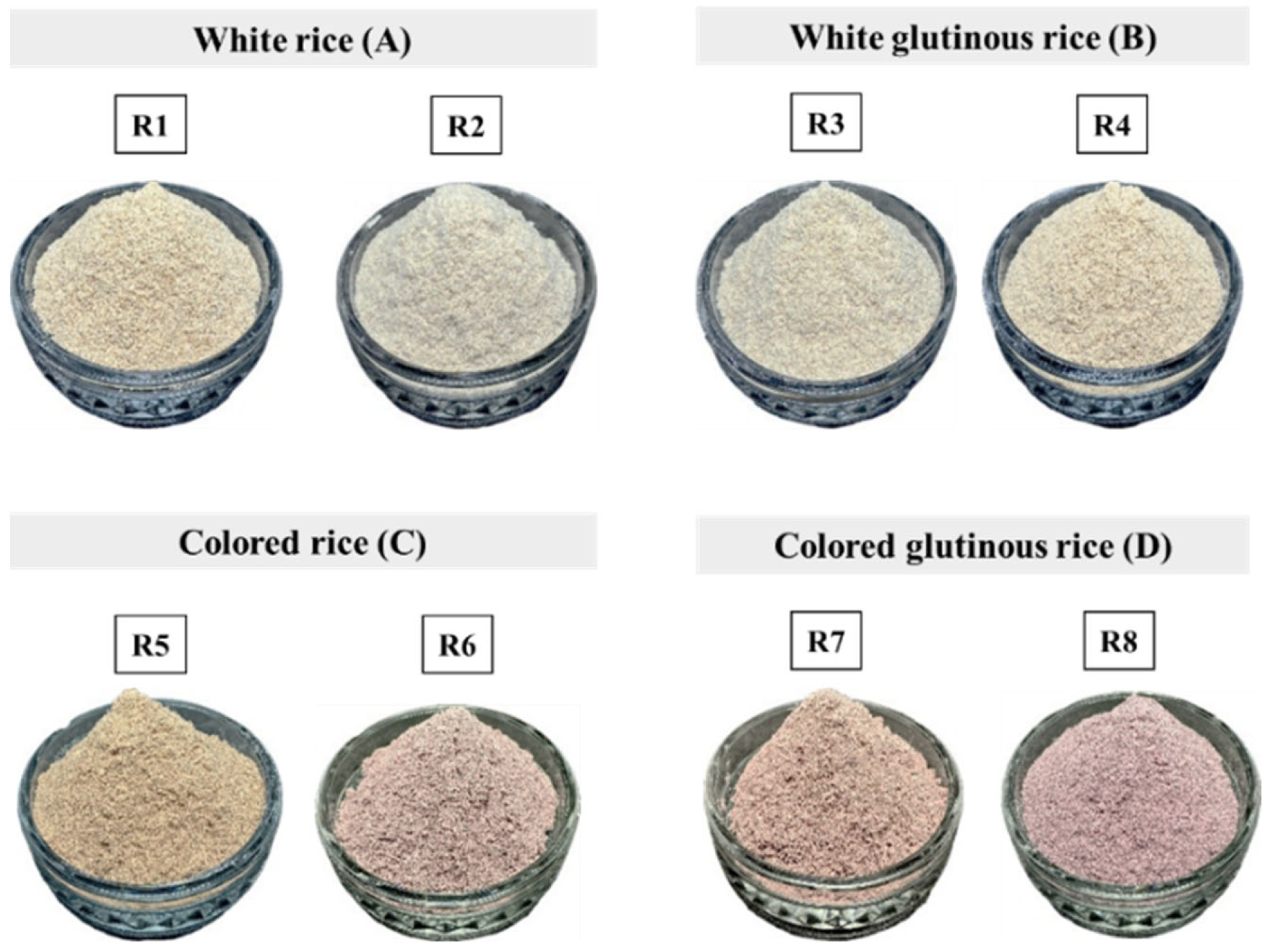

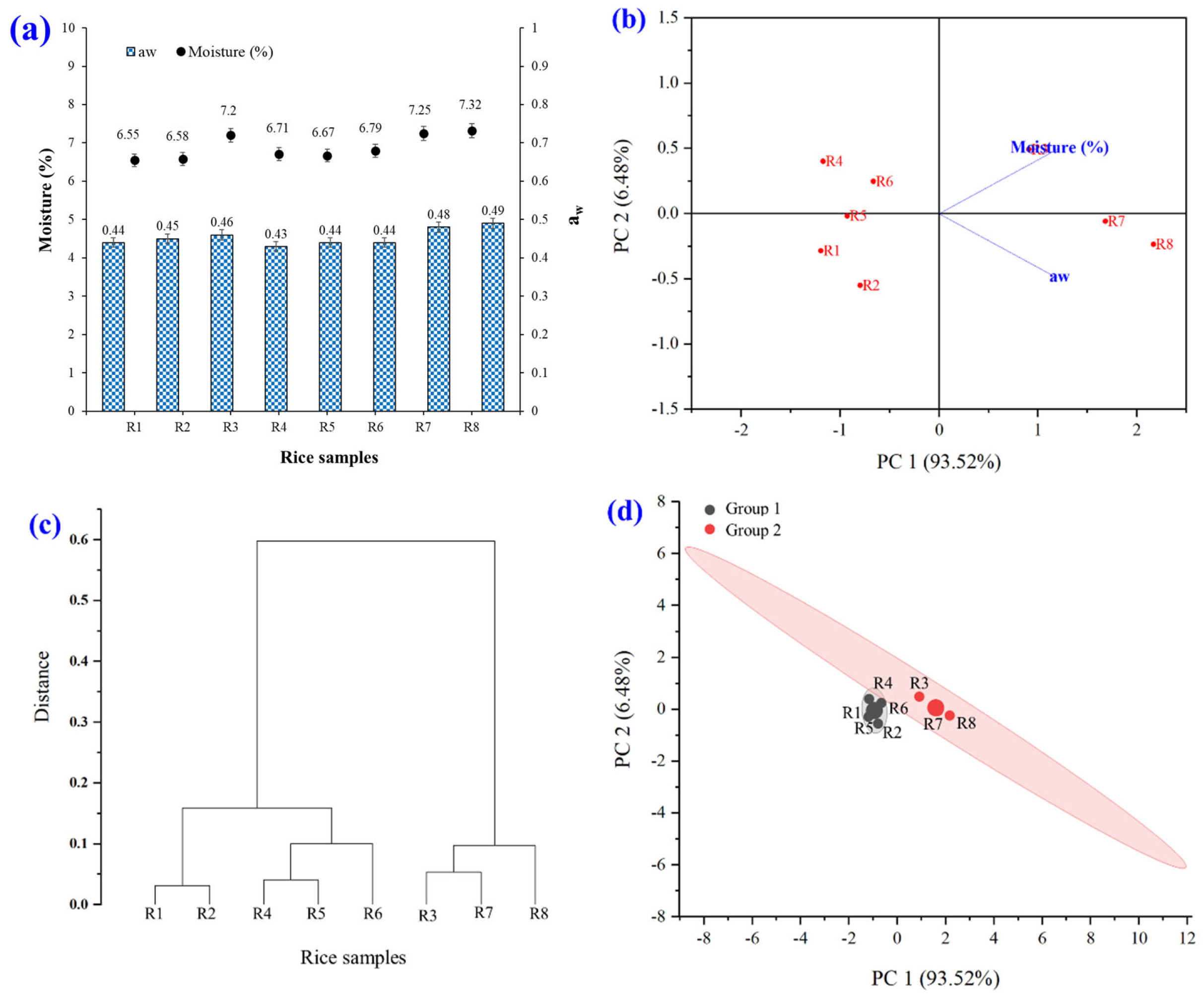

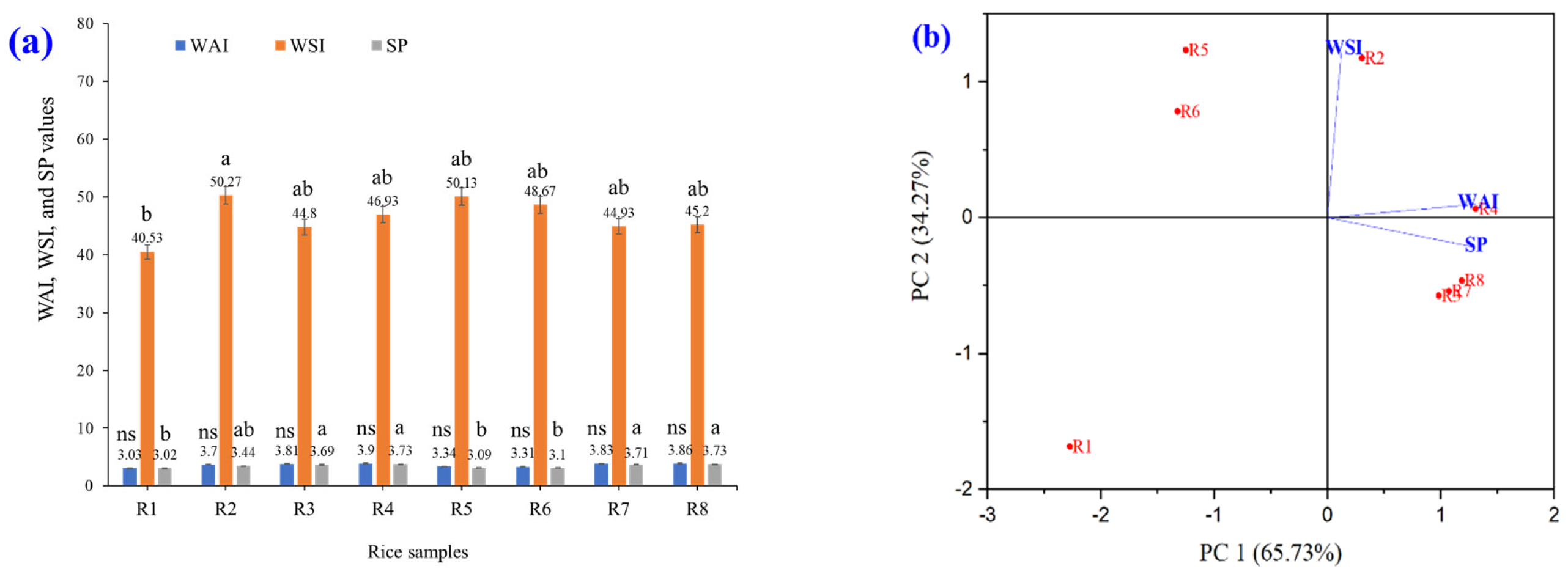
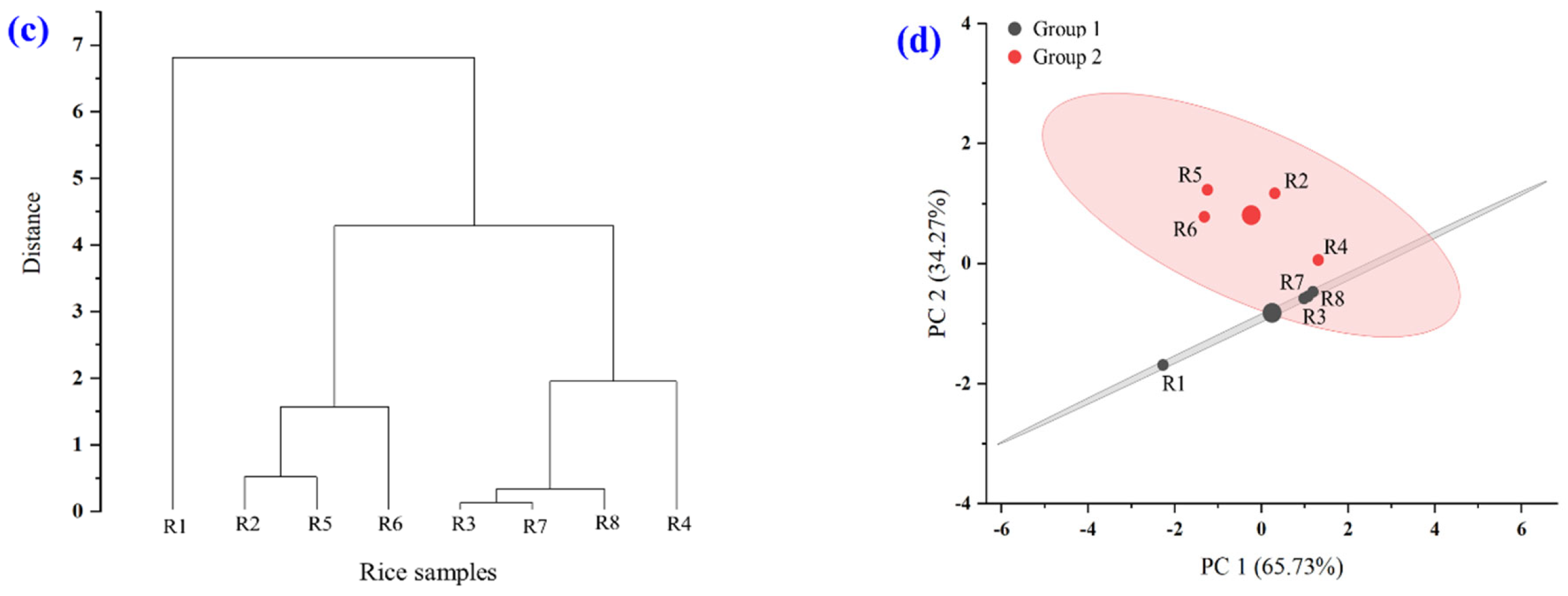
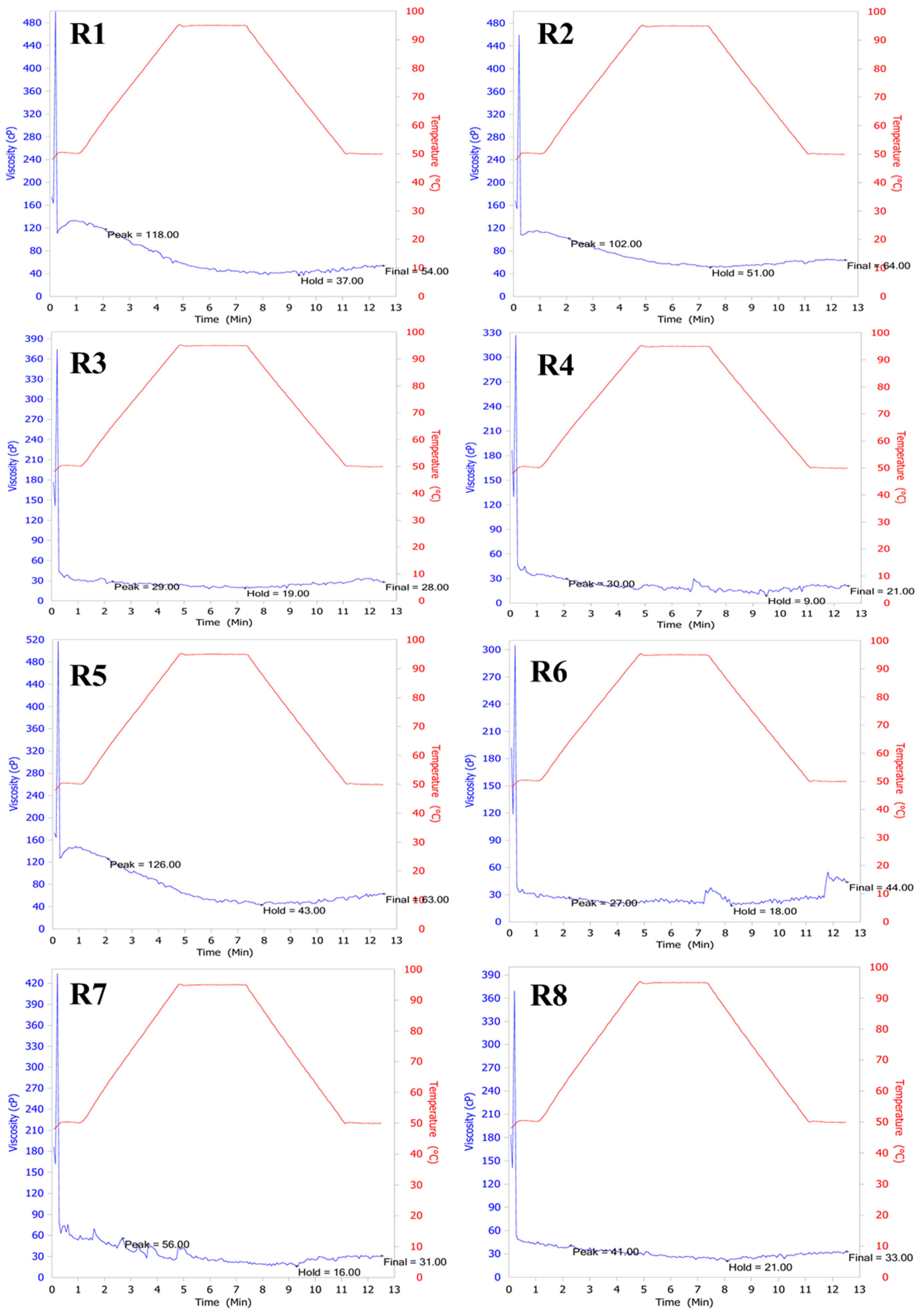


| Chemical Composition (per 100 g Brown Rice) | Rice Samples | |||||||
|---|---|---|---|---|---|---|---|---|
| R1 | R2 | R3 | R4 | R5 | R6 | R7 | R8 | |
| Moisture (g) | 12.53 ± 0.10 cd | 12.41 ± 0.11 d | 12.30 ± 0.14 d | 13.45 ± 0.21 b | 13.32 ± 0.22 b | 12.76 ± 0.20 b | 13.24 ± 0.10 b | 13.97 ± 0.20 a |
| Protein (g) | 9.48 ± 0.17 b | 8.96 ± 0.21 c | 8.36 ± 0.15 d | 7.58 ± 0.15 e | 8.89 ± 0.21 c | 9.44 ± 0.29 b | 10.93 ± 0.26 a | 8.37 ± 0.23 d |
| Fat (g) | 3.27 ± 0.14 abc | 2.96 ± 0.24 c | 2.95 ± 0.21 c | 1.49 ± 0.17 d | 3.35 ± 0.25 ab | 3.61 ± 0.26 a | 3.18 ± 0.15 bc | 1.50 ± 0.19 d |
| Ash (g) | 1.26 ± 0.18 a | 1.22 ± 0.18 a | 1.43 ± 0.22 a | 0.75 ± 0.17 b | 1.23 ± 0.21 a | 1.46 ± 0.17 a | 1.55 ± 0.12 a | 0.72 ± 0.23 b |
| Total carbohydrate (g) | 71.10 ± 0.13 d | 72.17 ± 0.16 c | 72.16 ± 0.27 c | 73.93 ± 0.21 a | 70.70 ± 0.17 e | 67.56 ± 0.24 g | 68.56 ± 0.11 f | 73.60 ± 0.14 b |
| Total dietary fiber (g) | 2.35 ± 0.25 c | 2.28 ± 0.17 c | 2.79 ± 0.22 b | 2.80 ± 0.10 b | 2.50 ± 0.21 bc | 5.17 ± 0.18 a | 2.54 ± 0.26 bc | 1.84 ± 0.25 d |
| Reducing sugar (g) | 0.34 ± 0.20 a | <0.26 ± 0.24 ab | <0.26 ± 0.13 ab | 0.00 ± 0.01 b | <0.26 ± 0.12 ab | <0.26 ± 0.15 ab | 0.36 ± 0.12 a | 0.45 ± 0.21 a |
| Energy (Kcal) | 361.19 ± 0.18 a | 360.28 ± 0.29 b | 359.83 ± 0.31 b | 350.65 ± 0.24 e | 358.55 ± 0.32 c | 361.17 ± 0.25 a | 356.74 ± 0.23 d | 348.74 ± 0.31 f |
| Rice Samples | Extraction Yield (%) | Total Monomeric Anthocyanin (µg/g Dry Weight) | Total Phenolic Compounds (mg GAE/g Dry Weight) |
|---|---|---|---|
| R1 | 1.84 | 0.03 ± 0.00 c | 107.20 ± 1.25 g |
| R2 | 1.67 | 0.01 ± 0.00 d | 65.83 ± 1.26 g |
| R3 | 1.63 | 0.01 ± 0.00 cd | 62.72 ± 1.06 f |
| R4 | 2.72 | 0.01 ± 0.00 d | 120.80 ± 1.77 e |
| R5 | 1.57 | 0.01 ± 0.00 d | 131.23 ± 2.62 d |
| R6 | 1.57 | 0.01 ± 0.00 cd | 161.43 ± 4.35 c |
| R7 | 2.32 | 0.06 ± 0.01 b | 249.72 ± 4.95 a |
| R8 | 1.65 | 0.19 ± 0.01 a | 196.49 ± 2.15 b |
| Rice Samples | DPPH Assay (IC50 mg/mL) | FRAP Assay (mg Ascorbic Acid Equivalents/g Dry Weight) |
|---|---|---|
| R1 | 1.15 ± 0.01 d | 1.22 ± 0.15 d |
| R2 | 1.81 ± 0.10 b | ND |
| R3 | 1.43 ± 0.02 c | ND |
| R4 | 2.00 ± 0.10 a | ND |
| R5 | 0.49 ± 0.01 e | 5.46 ± 0.15 c |
| R6 | 0.48 ± 0.02 ef | 7.78 ± 0.02 b |
| R7 | 0.42 ± 0.02 ef | 9.88 ± 0.00 a |
| R8 | 0.31 ± 0.00 g | 5.74 ± 0.16 c |
Disclaimer/Publisher’s Note: The statements, opinions and data contained in all publications are solely those of the individual author(s) and contributor(s) and not of MDPI and/or the editor(s). MDPI and/or the editor(s) disclaim responsibility for any injury to people or property resulting from any ideas, methods, instructions or products referred to in the content. |
© 2025 by the authors. Licensee MDPI, Basel, Switzerland. This article is an open access article distributed under the terms and conditions of the Creative Commons Attribution (CC BY) license (https://creativecommons.org/licenses/by/4.0/).
Share and Cite
Wongsa, J.; Khawsuk, W.; Semangeon, T.; Oupkaew, P.; Venkatachalam, K.; Nuurai, P.; Charoenphun, N. Quality Evaluation of Ready-to-Use Various Brown Rice (Oryza sativa) Powder Using Extrusion Process. Foods 2025, 14, 3948. https://doi.org/10.3390/foods14223948
Wongsa J, Khawsuk W, Semangeon T, Oupkaew P, Venkatachalam K, Nuurai P, Charoenphun N. Quality Evaluation of Ready-to-Use Various Brown Rice (Oryza sativa) Powder Using Extrusion Process. Foods. 2025; 14(22):3948. https://doi.org/10.3390/foods14223948
Chicago/Turabian StyleWongsa, Jittimon, Witoon Khawsuk, Tistaya Semangeon, Prateep Oupkaew, Karthikeyan Venkatachalam, Parinyaporn Nuurai, and Narin Charoenphun. 2025. "Quality Evaluation of Ready-to-Use Various Brown Rice (Oryza sativa) Powder Using Extrusion Process" Foods 14, no. 22: 3948. https://doi.org/10.3390/foods14223948
APA StyleWongsa, J., Khawsuk, W., Semangeon, T., Oupkaew, P., Venkatachalam, K., Nuurai, P., & Charoenphun, N. (2025). Quality Evaluation of Ready-to-Use Various Brown Rice (Oryza sativa) Powder Using Extrusion Process. Foods, 14(22), 3948. https://doi.org/10.3390/foods14223948









